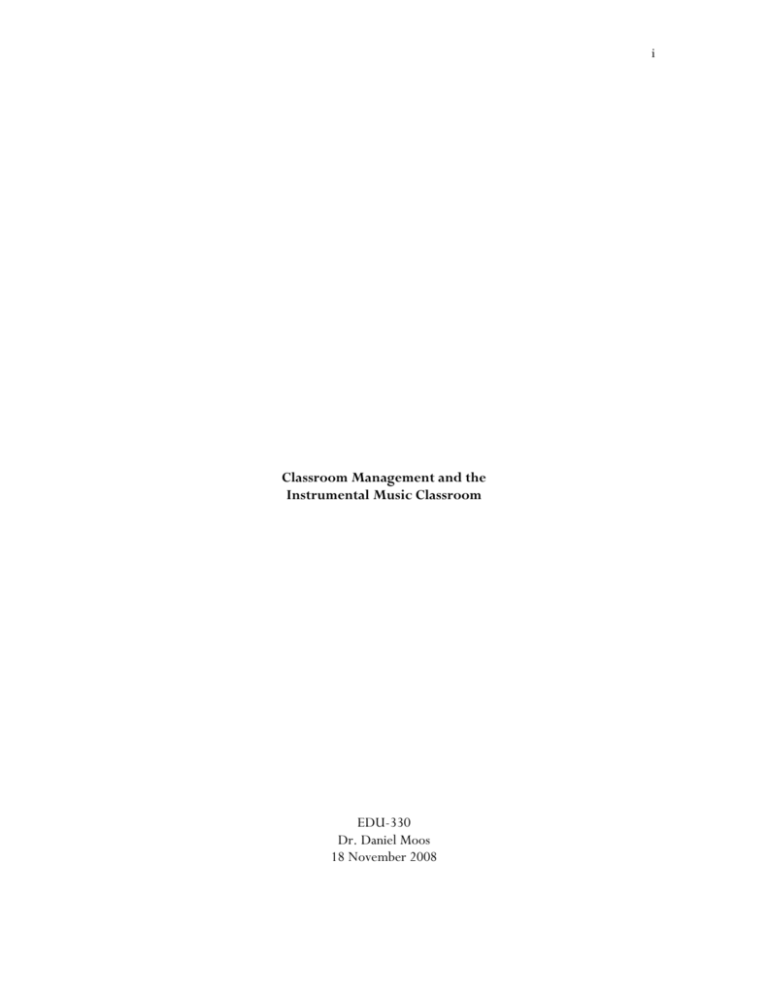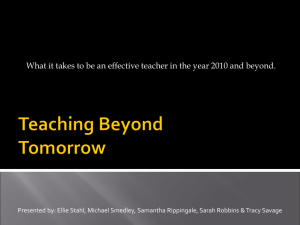
i
Classroom Management and the
Instrumental Music Classroom
EDU-330
Dr. Daniel Moos
18 November 2008
1
What comes to mind when you hear the words “classroom management”? Many people
think of a school classroom in utter chaos: students socializing during work time, projectiles flying
across the room, a fight breaking out in the corner, and a helpless teacher wondering, “where did I
go wrong?”. Eggen and Kauchak (2007) cite classroom management as the primary concern of
preservice teachers (p. 369), and I am no exception to this citation. I am very excited to teach in a
classroom someday, but confess my concern that students will not behave or listen. This paper,
therefore, seeks to further explore the concepts of classroom management, with an emphasis on
challenges specific to the instrumental music (band) classroom.
Classroom management is defined as “teachers’ strategies that create and maintain an
orderly learning environment” (Eggen & Kauchak, 2007, p. 371). Classroom management is to be
differentiated from discipline, which is the response to misbehavior. The distinction is important
to make because teachers’ views of classroom management are often discipline-focused. However,
as psychologist Jacob Kounin claims, discipline is just a small part of classroom management (Eggen
& Kauchak, 2007, p. 371). Most of classroom management should be a proactive, rather than
reactive, process. Just as the United States declared war on Iraq before a direct attack occurred,
teachers can use classroom management as a sort of “preemptive strike” against misbehavior (here
defined as anything that prevents learning) before it attacks them. The process of classroom
management, however, is less controversial than declaring war; it is instead an essential ingredient
to maximizing learning in the classroom.
Three principal classroom management goals, as detailed by Eggen and Kauchak (2007, p.
371), are outlined below. Interestingly, each goal corresponds to a different basic need of the selfdetermination theory of motivation, a theory dealing with “the process of deciding how to act on
one’s environment” (Eggen & Kauchak, 2007, p. 321). This is ultimately what teachers want to
teach students beyond content: how to shape the world they live in. The following sections will
2
describe each classroom management goal, how it relates to the motivation theory, and then apply
each goal specifically to the instrumental music classroom.
Corresponding psychological need from
Classroom management goal
self-determination theory
I. Create a positive classroom climate
Relatedness
II. Maximize opportunity for learning
Competence
III. Develop learner responsibility
Autonomy
I. Positive Classroom Climate
One indicator of a well-managed classroom is a positive classroom climate. According to
self-determination theory, students have a need for relatedness, feeling connected and loved (Eggen
& Kauchak, 2007, p. 321). A teacher can do much to meet this need by fostering a positive
classroom climate. A primary way to do this is by demonstrating caring, valuing students as people
as well as learners. According to humanistic psychologists, viewing and treating students with
unconditional positive regard means separating behavior from character, and starting fresh each day
(Kelly, 2008, para. 11).
In the band room, a challenge for the teacher is often the sheer number of students in the
classroom. A typical school symphonic band can have upwards of sixty players – a challenge, to be
sure, for a teacher to demonstrate caring to individual students when there are so many individuals!
One relatively simple way to demonstrate caring is to learn students’ names from the very start of
the school year (Wagener, 2008, para. 2). A teacher can carefully study a seating chart, or make a
video of students introducing themselves by instrumental section. The learning of student names,
3
while simple, communicates to students that the teacher is committed to each student as an
individual rather than primarily as a trumpet player or flautist.
The private lesson time is as critical a part of creating a personal, positive classroom climate
as it is a part of assessment. These times become valuable for speaking to each student one-on-one,
providing an opportunity for band teachers to get to know a student personally. This opportunity
should be used wisely; meeting regularly with individual students is not a characteristic part of
other disciplines.
Another factor in creating a positive classroom environment is providing feelings of safety:
learners should feel physically and emotionally secure (Eggen & Kauchak, 2007, p. 348). This
becomes a particular challenge in the band room. Often the aspect of solo performance is “scary”
to students, and they feel vulnerable in the classroom when asked to play a solo or demonstrate a
passage alone. The teacher can take several measures to foster emotional security in the classroom
while developing performance skills. Demonstration of caring is one step. Another is an explicit
emphasis on the class as being a “haven of creativity” (Musco, 2008, para. 7), with an emphasis on
process instead of results. Taking away the importance of perfection makes it “okay” to make
mistakes as part of learning. Frequent performance opportunities and teaching solo-related skills
such as improvisation can lead to increased confidence, as well. Finally, scaffolding can also be
employed: for example, having the clarinet section play a passage together, then two players, then
one player alone.
II. Maximizing Learning
Maximizing the opportunity for learning involves striving to make the most effective use of
limited time resources in order to have students involved in learning more, with less time spent in
administrative tasks and busywork. The goal is to make as much of classroom time as possible be
academic learning time, when students are actively and successfully involved in learning activities
4
(Eggen & Kauchak, 2007, p. 372). This corresponds to self-determination theory’s need for
competence, the ability to be successful in one’s environment (Eggen & Kauchak, 2007, p. 321).
With more time on task, an increasing number of students will feel an increasing amount of
competence.
To this end, organization is a major component to maximizing learning. A well-planned
(indeed, “over-planned” [Kelly, 2008, para. 8]) and well-paced lesson is the key to a time of
productive learning (“Discipline,” 2008, para. 5). One major organizational tool in the band
classroom is the syllabus. Due to the nature of instrumental music, there are often numerous small
details to remember: private lessons, school-owned instruments, extra rehearsals, performance
dates, call times, extracurricular ensembles, auditions, and the like. To have all these details laid
out for students at the beginning of the year is a daunting task, but becomes a valuable time-saver as
the year progresses: both the students and teacher can use the detailed syllabus (sometimes called a
“handbook”) as a resource. Laying out specific information for everyone from the start is easier and
more efficient than presenting isolated tidbits throughout the year on a more individual basis.
Furthermore, this tool lets students and parents know that the instructor is well-organized and
thoughtful about how their classroom operates.
A second component of maximizing learning is establishing routines and procedures as a
way to stay organized and bring efficiency to the classroom. Having a set amount of time to
assemble instruments before group warm-up begins (i.e. if the period starts at 10:06; students are
expected to be in their seats with instruments assembled and music in order at 10:10) and
establishing protocol for when the conductor steps onto the podium (i.e. silence, instruments “at
the ready”) creates structure and saves time. Another important consideration for instrumental
teachers is carefully pacing the lesson at the end to allow sufficient time for disassembly of
instruments. In the hustle and bustle of running to classes, being respectful of students’ time – and
5
therefore, giving them sufficient time to put their instruments away before the bell rings – is another
important addition of structure to the class. It demonstrates caring and respect, cuts down on
student stress, and demonstrates organization.
For the amount of active learning in a band classroom where every student gets to play an
instrument, it seems student boredom would be relatively nonexistent. Unfortunately, this is not
true; the same rehearsal routine, while a powerful organizing factor, can get tiring day after day.
Moreover, some students view band as less important than other commitments (especially busy
high school students), and can get frustrated sitting in a chair holding a euphonium when they could
be in study hall getting homework done. Also, working with sections on difficult passages can be
boring for other sections (i.e. percussionists daydreaming while the conductor drills a section with
flutes and oboe). Fortunately, there are several steps a teacher can take to decrease boredom,
promote interest and motivation, and create a better-managed classroom. The teacher should pick
a variety of interesting and appropriately challenging repertoire that is challenging for all
instrumental parts. Continually stressing the importance and enjoyment of music stresses the value
of music and promotes motivation. When working with only a part of the band, keep the rest of
the students actively engaged by asking them questions about what they heard. Finally, know how
to say (and teach) the same thing “a thousand different ways” (“Discipline,” 2008, para. 6).
While routines and procedures are invaluable, so is variety. Breaking out of the routine by
sight-reading repertoire, establishing new seating arrangements, or changing the way a piece is
played can add variety to the rehearsal. Breaking out even further, lessons on music theory,
conducting, composer spotlights, listening, film and film music analysis, composing, or sectionleader-led sectionals can add interest and a more comprehensive curriculum to a class by way of
variety. These techniques also take emphasis away from “the concert,” stressing that music can be
enjoyed in the moment rather than all music being in the service of performance.
6
III. Student Responsibility
The ultimate goal of educators in regard to classroom management is to teach students how
to teach themselves; that is, to teach responsibility. Responsible students are intrinsically
motivated and take charge of their own learning. This relates to self-determination theory’s need
for autonomy, the ability to change one’s environment (Eggen & Kauchak, 2007, p. 322).
An important strategy for shaping student responsibility involves rule setting and logical
consequences (“Discipline,” 2008, para. 18; Eggen & Kauchak, 2007, p. 393). Rules should be
understandable (Kelly, 2008, para. 10), and teachers should encourage student input when forming
rules to create a sort of “contract” between the student and teacher (and possibly parent, too)
(“Discipline,” 2008, para. 11). In this way, students are responsible for their own learning and
behavior, and the teacher becomes more a facilitator or partner to achieving this end rather than an
enforcer. In the band classroom, it is especially important to maintain high standards and create
appropriate assessments to develop student responsibility. Scale tests and repertoire checks as part
of the private lesson program are an important ingredient, as well as fair grading so the class is not
seen as the “easy A” students (and teachers) sometimes perceive it to be.
Finally, the band classroom can easily become a teacher-centered domain. The conductor
is traditionally on a podium, physically above students, and students are expected to play
instruments according to subtle conducting motions, emphasizing teacher control. While it is
important to maintain an authoritative presence as a teacher, there are many ways to provide more
opportunities for students to take responsibility for their own learning. Simply dismounting the
podium and moving about the room while conducting is one easy strategy for deemphasizing
teacher-centeredness and communicating to students everyone is “in this together.” Eliciting
responses from students rather than the conductor giving all rehearsal suggestions gives autonomy
and responsibility to students. This can be scaffolded by posting a list of musical elements in the
7
room, and prompting students as they learn to listen and critique their own performance. The
teacher could even teach conducting and have students conduct rehearsals when appropriate.
Lastly, a group of student leaders can form a sort of “music council” and assist in setting goals for
the ensemble, selecting repertoire, and organizing parts of class.
While these strategies do not necessarily fit the standard discipline-oriented view of
classroom management, these proactive approaches are even more important than reactive
discipline. And while discipline is necessary for certain occasions, this outline for a “preemptive
classroom management strike” should be an effective preventative measure to decrease disruption
and promote productive, positive, learning-centered classrooms.
8
References
Discipline Strategies in the Music Classroom. (2008). Retrieved November 15, 2008, from
http://www.teachervision.com/music/behavior/6763.html
Eggen, P., & Kauchak, D. (2007). Educational Psychology. Columbus: Pearson Prentice Hall.
Kelly, M. (2008). Top 10 Tips for Classroom Discipline and Management. Retrieved November 15,
2008, from http://712educators.about.com/od/discipline/tp/disciplinetips.htm
Musco, A. (2008). Smart Starts for a Successful School Year. Retrieved November 15, 2008, from
http://www.menc.org/v/future_teachers/menc-collegiate-october-2008-newslink
Wagener, A. (2008). Ten Ways to Encourage Good Student Behavior. Retrieved November 15, 2008,
from http://www.menc.org/v/future_teachers/ten-ways-to-encourage-student-behavior









